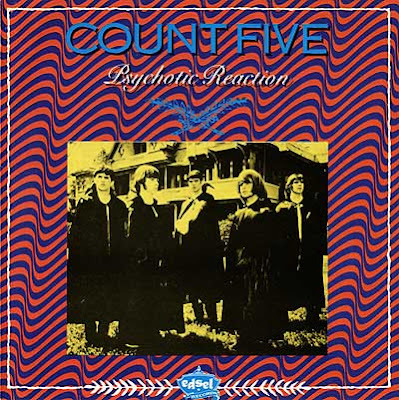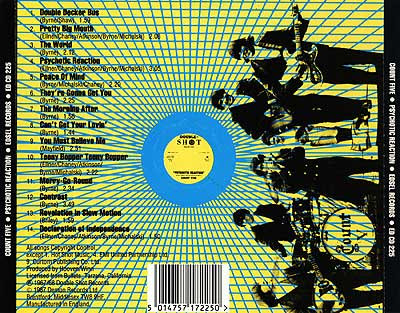"Psychotic Reaction" is one of those songs that never seems to die, and turns up on mid 1960s rock compilations far more often than you'd think given that the Count Five were one-hit wonders. Thankfully, most of the rest of this CD is cut from similar cloth. Lots of garage punks tried to emulate British rockers like the Yardbirds, but the Count Five came closer than most. If the production values on this CD were slightly better, it could almost pass for something recorded way back in Swinging London and to be very honest it is no worse (or better) than early LPs by the Kinks or the Dave Clark Five.
In other words, this music is pretty darned fun to listen to. Most garage punks made truly awful albums, but this one is a pleasant surprise because the good outweighs the bad. You'll probably eventually go back to listening only to the title song after a few listens, but I think any self-respecting garage punk will want this in their permanent collection. I'm glad I have mine! --Amazon customer review![Count-Five-Psychotic-Reaction-1.jpg]() The Count Five was a 1960s garage rock band from San Jose, California, best known for their Top 10 single "Psychotic Reaction".
The Count Five was a 1960s garage rock band from San Jose, California, best known for their Top 10 single "Psychotic Reaction".
The band was founded in 1964 by John "Mouse" Michalski (born 1948, Cleveland, Ohio) (lead guitar) and Roy Chaney (born 1948, Indianapolis, Indiana) (bass guitar), two high school friends who had previously played in several short-lived bands. After going by the name The Squires for a short time, along with several line-up changes, the Count Five were born. John "Sean" Byrne (1947-2008, born Dublin, Ireland) played rhythm guitar and lead vocals, and Craig "Butch" Atkinson (1947-1998, born San Jose, California) played drums. The Count Five gained distinction for their habit of wearing Count Dracula-style capes when playing live.
"Psychotic Reaction", an acknowledged cornerstone of garage rock, was initially devised by Byrne, with the group refining it and turning it into the highlight of their live sets. The song was influenced by the style of contemporary musicians such as The Standells and The Yardbirds.[citation needed] The band was rejected by several record labels before they got signed to the Los Angeles-based Double Shot Records. "Psychotic Reaction" was released as a single, peaking at #5 in the U.S. charts in late 1966. The band enjoyed limited success for a short time, dropping out of view altogether when their only hit had fallen from public memory. Another setback to a potential career in the music business was the decision of the five members (who were between the ages of 17 and 19) to pursue college degrees.
By 1969, the Count Five had broken up, but their memory was immortalized in a 1972 essay by rock journalist Lester Bangs, entitled "Psychotic Reactions and Carburetor Dung." In the essay, Bangs credited the band for having released several later albums (after Psychotic Reaction): Carburetor Dung, Cartesian Jetstream, Ancient Lace and Wrought-Iron Railings, and Snowflakes Falling On the International Dateline — each displaying an increasing sense of artistry and refinement. However none of these subsequent albums actually existed except in Bangs' own imagination.
The Count Five reunited only once, when they performed a concert in 1987 at a club in Santa Clara, California called "One Step Beyond". This performance has been released as Psychotic Reunion LIVE!.
The song "Psychotic Reaction" can be heard playing on the jukebox in an early scene in Wim Wenders' film Alice in the Cities (1974).
Craig Atkinson died on October 13, 1998 and John "Sean" Byrne died on December 15, 2008 at 61 from cirrhosis of the liver.
Roy Chaney formed a new band in the 1990s called The Count (with Byrne and drummer Rocco Astrella, who played in the last version of the original group). The Count released their debut CD, Can't Sleep, in 2002. In 2006, Count Five was among the first bands inaugurated into the San Jose Rock Hall of Fame.![Count-Five-Psychotic-Reaction-2.jpg]() trax;
trax;
In other words, this music is pretty darned fun to listen to. Most garage punks made truly awful albums, but this one is a pleasant surprise because the good outweighs the bad. You'll probably eventually go back to listening only to the title song after a few listens, but I think any self-respecting garage punk will want this in their permanent collection. I'm glad I have mine! --Amazon customer review
 The Count Five was a 1960s garage rock band from San Jose, California, best known for their Top 10 single "Psychotic Reaction".
The Count Five was a 1960s garage rock band from San Jose, California, best known for their Top 10 single "Psychotic Reaction".The band was founded in 1964 by John "Mouse" Michalski (born 1948, Cleveland, Ohio) (lead guitar) and Roy Chaney (born 1948, Indianapolis, Indiana) (bass guitar), two high school friends who had previously played in several short-lived bands. After going by the name The Squires for a short time, along with several line-up changes, the Count Five were born. John "Sean" Byrne (1947-2008, born Dublin, Ireland) played rhythm guitar and lead vocals, and Craig "Butch" Atkinson (1947-1998, born San Jose, California) played drums. The Count Five gained distinction for their habit of wearing Count Dracula-style capes when playing live.
"Psychotic Reaction", an acknowledged cornerstone of garage rock, was initially devised by Byrne, with the group refining it and turning it into the highlight of their live sets. The song was influenced by the style of contemporary musicians such as The Standells and The Yardbirds.[citation needed] The band was rejected by several record labels before they got signed to the Los Angeles-based Double Shot Records. "Psychotic Reaction" was released as a single, peaking at #5 in the U.S. charts in late 1966. The band enjoyed limited success for a short time, dropping out of view altogether when their only hit had fallen from public memory. Another setback to a potential career in the music business was the decision of the five members (who were between the ages of 17 and 19) to pursue college degrees.
By 1969, the Count Five had broken up, but their memory was immortalized in a 1972 essay by rock journalist Lester Bangs, entitled "Psychotic Reactions and Carburetor Dung." In the essay, Bangs credited the band for having released several later albums (after Psychotic Reaction): Carburetor Dung, Cartesian Jetstream, Ancient Lace and Wrought-Iron Railings, and Snowflakes Falling On the International Dateline — each displaying an increasing sense of artistry and refinement. However none of these subsequent albums actually existed except in Bangs' own imagination.
The Count Five reunited only once, when they performed a concert in 1987 at a club in Santa Clara, California called "One Step Beyond". This performance has been released as Psychotic Reunion LIVE!.
The song "Psychotic Reaction" can be heard playing on the jukebox in an early scene in Wim Wenders' film Alice in the Cities (1974).
Craig Atkinson died on October 13, 1998 and John "Sean" Byrne died on December 15, 2008 at 61 from cirrhosis of the liver.
Roy Chaney formed a new band in the 1990s called The Count (with Byrne and drummer Rocco Astrella, who played in the last version of the original group). The Count released their debut CD, Can't Sleep, in 2002. In 2006, Count Five was among the first bands inaugurated into the San Jose Rock Hall of Fame.
 trax;
trax;01. Double Decker Bus 02. Pretty Big Mouth 03. The World 04. Psychotic Reaction 05. Peace Of Mind 06. They're Gonna Get You 07. The Morning After 08. Can't Get Your Lovin' 09. You Must Believe Me 10. Teeny Booper Teeny Bopper 11. Merry-Go-Round 12. Contrast 13. Revelation In Slow Motion 14. Declaration Of Independence
…originally served by Toxxy...